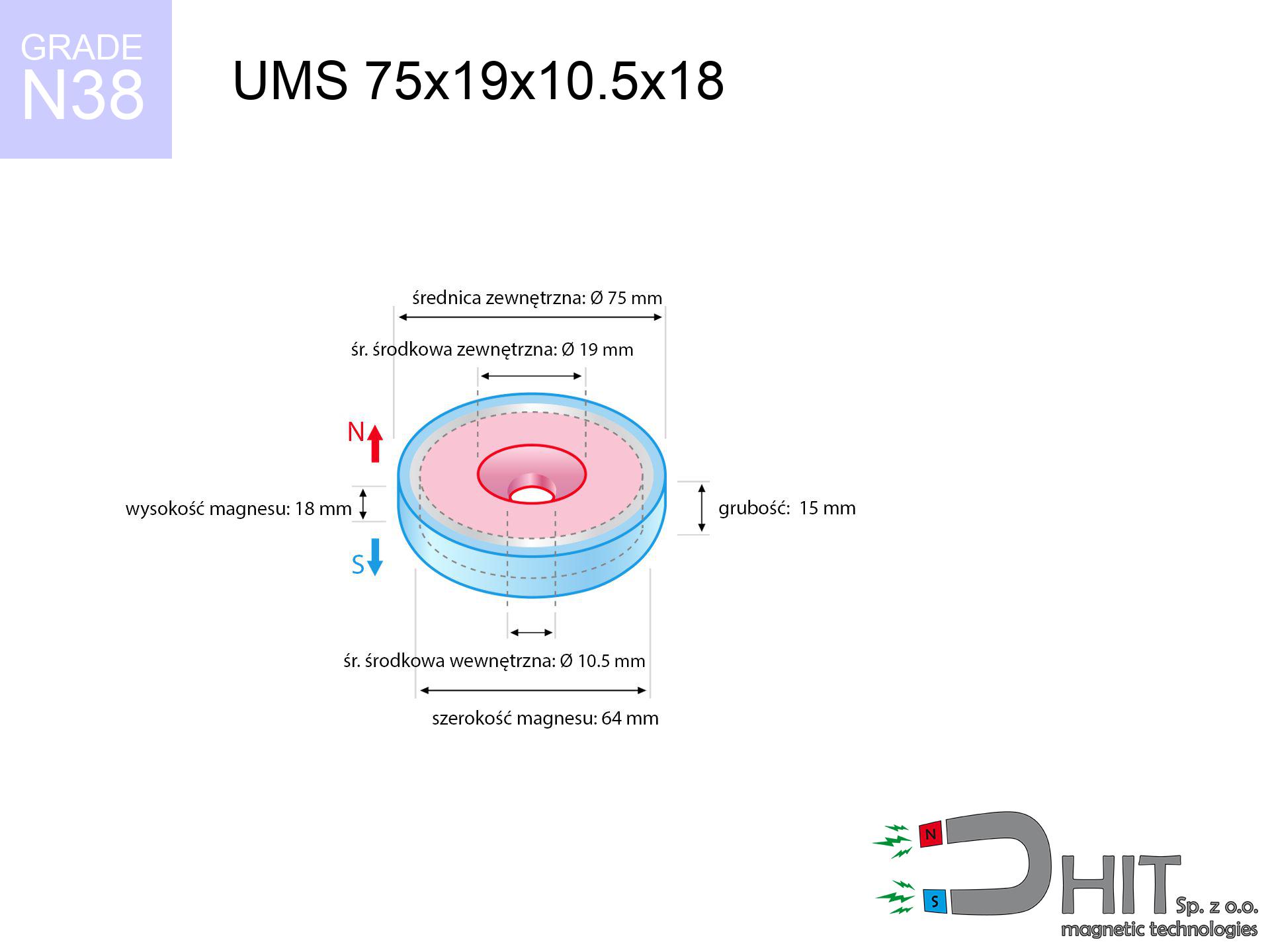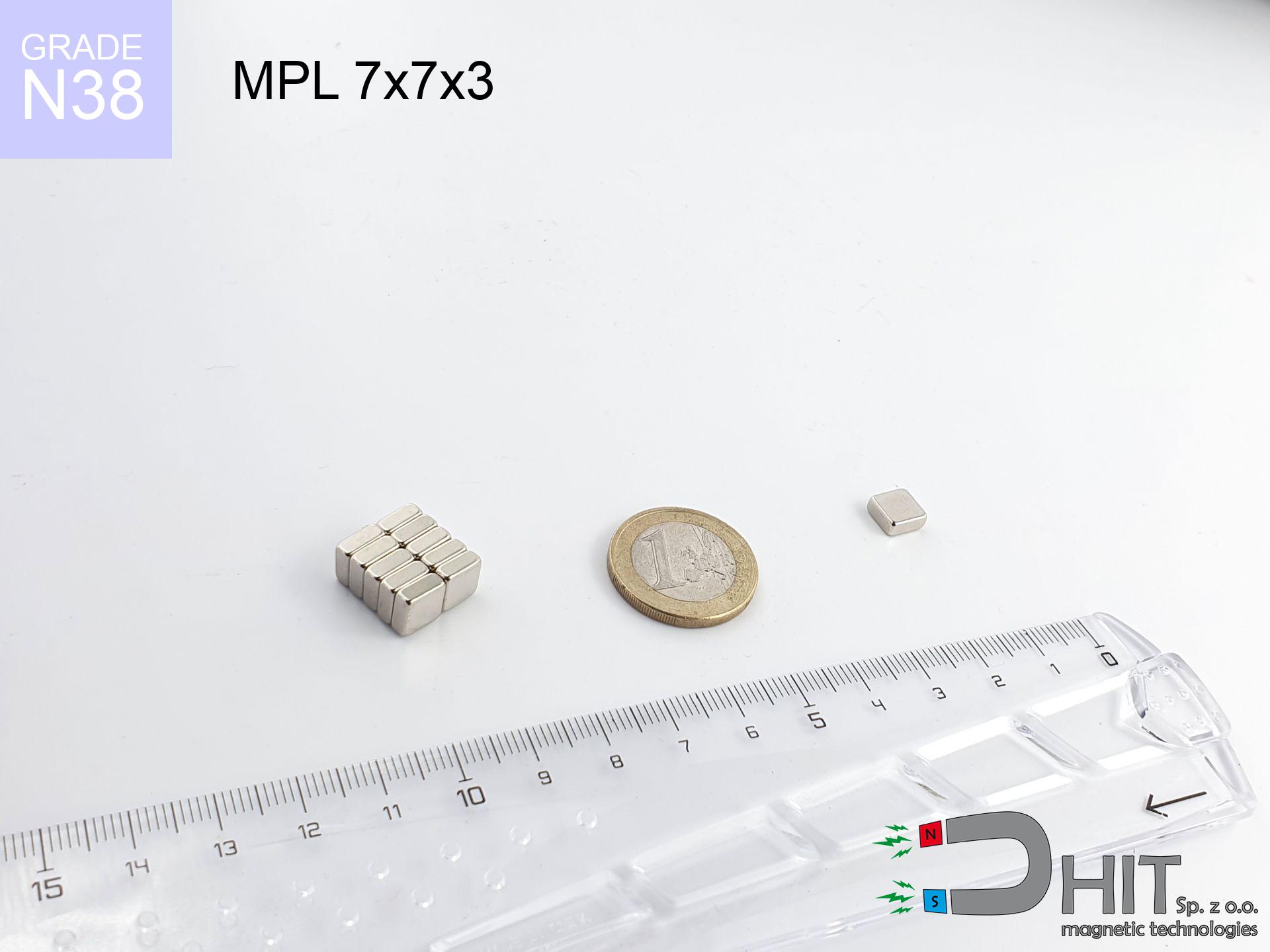UMS 75x19x10.5x18 / N38 - conical magnetic holder
conical magnetic holder
Catalog no 220405
GTIN/EAN: 5906301814245
Diameter Ø
75 mm [±1 mm]
cone dimension Ø
19x10.5 mm [±1 mm]
Height
18 mm [±1 mm]
Weight
465 g
Magnetization Direction
↑ axial
Load capacity
162.00 kg / 1588.68 N
Coating
[NiCuNi] Nickel
125.56 ZŁ with VAT / pcs + price for transport
102.08 ZŁ net + 23% VAT / pcs
bulk discounts:
Need more?
Contact us by phone
+48 22 499 98 98
if you prefer get in touch through
request form
through our site.
Lifting power and structure of magnetic components can be reviewed on our
magnetic calculator.
Orders submitted before 14:00 will be dispatched today!
Technical of the product - UMS 75x19x10.5x18 / N38 - conical magnetic holder
Specification / characteristics - UMS 75x19x10.5x18 / N38 - conical magnetic holder
| properties | values |
|---|---|
| Cat. no. | 220405 |
| GTIN/EAN | 5906301814245 |
| Production/Distribution | Dhit sp. z o.o. |
| Country of origin | Poland / China / Germany |
| Customs code | 85059029 |
| Diameter Ø | 75 mm [±1 mm] |
| cone dimension Ø | 19x10.5 mm [±1 mm] |
| Height | 18 mm [±1 mm] |
| Weight | 465 g |
| Magnetization Direction | ↑ axial |
| Load capacity ~ ? | 162.00 kg / 1588.68 N |
| Coating | [NiCuNi] Nickel |
| Manufacturing Tolerance | ±1 mm |
Magnetic properties of material N38
| properties | values | units |
|---|---|---|
| remenance Br [min. - max.] ? | 12.2-12.6 | kGs |
| remenance Br [min. - max.] ? | 1220-1260 | mT |
| coercivity bHc ? | 10.8-11.5 | kOe |
| coercivity bHc ? | 860-915 | kA/m |
| actual internal force iHc | ≥ 12 | kOe |
| actual internal force iHc | ≥ 955 | kA/m |
| energy density [min. - max.] ? | 36-38 | BH max MGOe |
| energy density [min. - max.] ? | 287-303 | BH max KJ/m |
| max. temperature ? | ≤ 80 | °C |
Physical properties of sintered neodymium magnets Nd2Fe14B at 20°C
| properties | values | units |
|---|---|---|
| Vickers hardness | ≥550 | Hv |
| Density | ≥7.4 | g/cm3 |
| Curie Temperature TC | 312 - 380 | °C |
| Curie Temperature TF | 593 - 716 | °F |
| Specific resistance | 150 | μΩ⋅cm |
| Bending strength | 250 | MPa |
| Compressive strength | 1000~1100 | MPa |
| Thermal expansion parallel (∥) to orientation (M) | (3-4) x 10-6 | °C-1 |
| Thermal expansion perpendicular (⊥) to orientation (M) | -(1-3) x 10-6 | °C-1 |
| Young's modulus | 1.7 x 104 | kg/mm² |
Material specification
| iron (Fe) | 64% – 68% |
| neodymium (Nd) | 29% – 32% |
| boron (B) | 1.1% – 1.2% |
| dysprosium (Dy) | 0.5% – 2.0% |
| coating (Ni-Cu-Ni) | < 0.05% |
Sustainability
| recyclability (EoL) | 100% |
| recycled raw materials | ~10% (pre-cons) |
| carbon footprint | low / zredukowany |
| waste code (EWC) | 16 02 16 |
See more deals
Strengths as well as weaknesses of neodymium magnets.
Advantages
- They retain magnetic properties for nearly ten years – the loss is just ~1% (according to analyses),
- Neodymium magnets are remarkably resistant to loss of magnetic properties caused by external interference,
- Thanks to the metallic finish, the coating of Ni-Cu-Ni, gold-plated, or silver gives an aesthetic appearance,
- Magnets are characterized by impressive magnetic induction on the outer side,
- Made from properly selected components, these magnets show impressive resistance to high heat, enabling them to function (depending on their shape) at temperatures up to 230°C and above...
- Possibility of individual shaping and modifying to individual needs,
- Key role in high-tech industry – they serve a role in magnetic memories, brushless drives, medical equipment, and complex engineering applications.
- Thanks to efficiency per cm³, small magnets offer high operating force, in miniature format,
Limitations
- At very strong impacts they can crack, therefore we advise placing them in steel cases. A metal housing provides additional protection against damage and increases the magnet's durability.
- We warn that neodymium magnets can reduce their power at high temperatures. To prevent this, we suggest our specialized [AH] magnets, which work effectively even at 230°C.
- When exposed to humidity, magnets start to rust. To use them in conditions outside, it is recommended to use protective magnets, such as those in rubber or plastics, which secure oxidation and corrosion.
- Limited ability of creating nuts in the magnet and complicated forms - recommended is a housing - magnetic holder.
- Health risk resulting from small fragments of magnets pose a threat, when accidentally swallowed, which is particularly important in the aspect of protecting the youngest. Additionally, small components of these devices are able to disrupt the diagnostic process medical after entering the body.
- With large orders the cost of neodymium magnets can be a barrier,
Lifting parameters
Best holding force of the magnet in ideal parameters – what it depends on?
- on a base made of mild steel, perfectly concentrating the magnetic field
- possessing a massiveness of min. 10 mm to avoid saturation
- with a plane free of scratches
- without any clearance between the magnet and steel
- for force applied at a right angle (pull-off, not shear)
- in temp. approx. 20°C
What influences lifting capacity in practice
- Gap between surfaces – every millimeter of separation (caused e.g. by varnish or dirt) drastically reduces the magnet efficiency, often by half at just 0.5 mm.
- Loading method – catalog parameter refers to pulling vertically. When slipping, the magnet exhibits significantly lower power (often approx. 20-30% of maximum force).
- Substrate thickness – for full efficiency, the steel must be adequately massive. Thin sheet limits the lifting capacity (the magnet "punches through" it).
- Steel grade – the best choice is pure iron steel. Stainless steels may generate lower lifting capacity.
- Surface finish – ideal contact is possible only on polished steel. Any scratches and bumps reduce the real contact area, weakening the magnet.
- Thermal conditions – NdFeB sinters have a negative temperature coefficient. At higher temperatures they lose power, and at low temperatures they can be stronger (up to a certain limit).
Holding force was measured on a smooth steel plate of 20 mm thickness, when the force acted perpendicularly, in contrast under attempts to slide the magnet the load capacity is reduced by as much as 75%. Additionally, even a small distance between the magnet’s surface and the plate reduces the holding force.
Safety rules for work with NdFeB magnets
Medical interference
For implant holders: Powerful magnets disrupt medical devices. Keep at least 30 cm distance or ask another person to work with the magnets.
Do not drill into magnets
Machining of NdFeB material carries a risk of fire risk. Neodymium dust oxidizes rapidly with oxygen and is difficult to extinguish.
Protect data
Intense magnetic fields can corrupt files on credit cards, hard drives, and storage devices. Stay away of min. 10 cm.
Allergic reactions
Some people suffer from a hypersensitivity to Ni, which is the common plating for neodymium magnets. Prolonged contact may cause a rash. We strongly advise wear protective gloves.
Power loss in heat
Monitor thermal conditions. Exposing the magnet to high heat will permanently weaken its magnetic structure and pulling force.
Fragile material
Watch out for shards. Magnets can explode upon violent connection, launching sharp fragments into the air. Wear goggles.
GPS and phone interference
Be aware: rare earth magnets produce a field that confuses precision electronics. Keep a separation from your mobile, tablet, and navigation systems.
Do not give to children
Product intended for adults. Small elements can be swallowed, leading to intestinal necrosis. Keep away from kids and pets.
Bone fractures
Large magnets can break fingers instantly. Never put your hand betwixt two attracting surfaces.
Do not underestimate power
Handle magnets consciously. Their powerful strength can surprise even professionals. Plan your moves and respect their power.




![UMGZ 20x15x7 [M4] GZ / N38 - magnetic holder external thread UMGZ 20x15x7 [M4] GZ / N38 - magnetic holder external thread](https://cdn3.dhit.pl/graphics/products/um-20x15x7-m4-gz-vaf.jpg)




